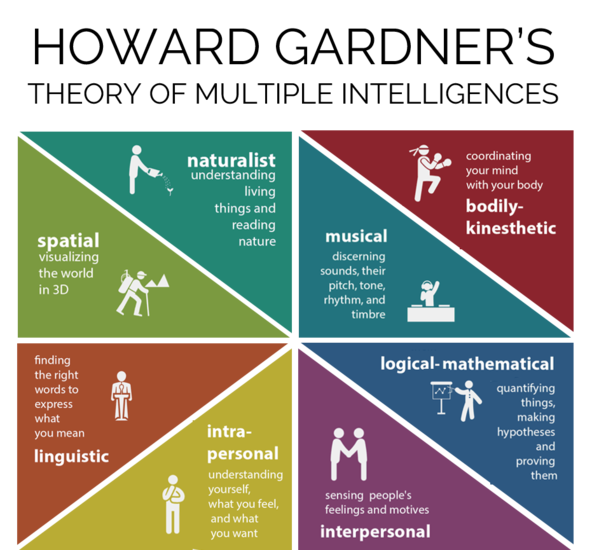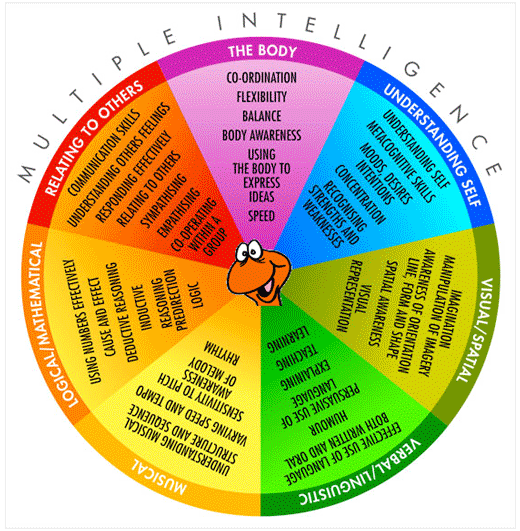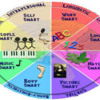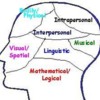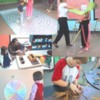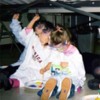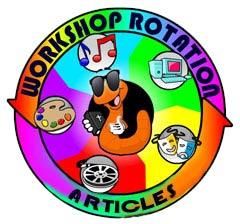
Revised and updated
"Multiple-Intelligences"
and the Workshop Rotation Model
...a Workshop Rotation Model Article
"Multiple Intelligences" is the name of the theory of learning and extensive body of research by Howard Gardner and his team of researchers at Harvard's Graduate School of Education. First published in the book "Frame of Mind," multiple intelligences identifies the seven (or eight) learning faculties or abilities that everyone has hard-wired in their brains.
While each of us has ALL of these learning aptitudes (capabilities) and use all of them in varying degrees, each of us also has our own preferred ways of learning.
For example, some people are naturally more attracted to the visuals than the words of a presentation, and they remember the content of words and visuals better (deeper) if they also move or sing, for example.
In other words, our brains learn through MANY different approaches, and the more approaches we use to learn something --the more likely we are to remember and understand what we've been learning.
The theory helps explain what creative teachers have always known, namely, that certain teaching methods are better for some learners than others, and a variety of teaching methods should be employed to create a richer, more well-rounded learning experience and deeper memory.
The Workshop Rotation Model for Sunday School provides a structured way to MAKE SURE we are teaching Bible content through many different approaches. We do it by centering our classroom lessons around a variety of specific learning techniques, including art, drama, music and movement, videos, software, cooking, games, and more! In Rotation Model terminology, we call these approach-focused classrooms "WORKSHOPS."
Don't teachers already use a variety of methods? Why create "workshops"? Because we know from decades of experience that volunteer teachers and traditional curriculum prefer a simple, "same old activities" approach to each lesson. Talk + Craft, and if you're lucky, a game that may or may not be on point. Rotation solves this problem by creating different workshops based on different teaching methods. The Rotation Model did not set out to base its model on Gardner's work, rather, Gardner's work CONFIRMS what creative teachers have known intuitively about the importance of varied approaches and created the structure to pull it off with volunteer teachers.
Since it's debut decades ago, Gardner's theory and research has been widely researched and accepted as an insightful and authoritative understanding of the mystery of how we process information and experience into what we call "learning." It has its critics, as do all theories, but to creative educators, it explains "enough" of what we know about our learners, and why the importance of teaching with multiple approaches is never in dispute!
The eight hard-wired intelligences or "smarts" are:
(The following text is excerpted from scholastic.com.)
1. Verbal-Linguistic (Word Strong)
These students speak, read, or write well. They like manipulating words (jokes and puns) and playing with language (word games). To develop verbal-linguistic intelligence, have students read and write in a variety of genres, give speeches, participate in performances, and hear the magic of language by reading telling stories. Have them create word games, crossword puzzles, and word searches. Model your love of language.
2. Logical-Mathematical (Math Strong)
These students are good with numbers and enjoy logic problems and puzzles. They enjoy figuring things out and coming up with unusual solutions. To develop logical-mathematical intelligence, use Think Alouds for solving mathematical problems. Ask students how they came up with the answer, why they think it's right, and if they can think of another way to solve the problem. Have them record information on graphs, establish time lines, and create maps. Let them explore how things work.
3. Visual-Spatial (Space Strong)
These students like to doodle and design. They "see" things differently in their minds, and they recognize spatial relationships. To develop visual-spatial intelligence, read stories with well-described visual images, such as James and the Giant Peach. Have students listen to the words the author uses and draw a picture from the description. Say, "I feel like I'm really there because I can 'see' what's happening." Let students demonstrate understanding through drawing, painting, sculpting, and creating backdrops and scenery for class plays. Use videos, slides, art, puzzles, and mazes.
4. Bodily-Kinesthetic Intelligence (Body Strong)
These students are highly aware of the world through touch and movement. There is a special harmony between their bodies and their minds. They can control their bodies with grace, expertise, and athleticism. To develop bodily-kinesthetic intelligence, provide time for students to act out skits or scenes in a book, play physical games like Twister and Simon Says, and build objects to represent concepts. Allowing movement breaks during the day, even quick stretches, is helpful as well.
5. Musical-Rhythmic (Music Strong)
These students are more affected by music, rhythm, and environmental sounds than others. They sing, whistle, hum, tap, and sway. They are able to attach feelings to music and can create and replicate tunes. To build musical-rhythmic intelligence, have students create songs or raps to explain concepts (e.g. a song describing the rock cycle), put their own learning to music, or participate in music and dance from a variety of sources. Play different types of music during the day.
6. Intrapersonal Intelligence (Self Strong)
These students are self-motivated and reflective. They watch and listen, taking in conversation rather than contributing to it. They prefer working alone, need quiet time to process new ideas, and daydream often. They usually need space and time away from hustle and bustle of the classroom agenda so they can pursue ideas in their own way. To develop intrapersonal intelligence, give students time at the end of each day to reflect on what they have learned and experienced in a journal, involve them in setting personal goals, and allow them to work at their own pace. Share your own reflections, listing two or three reasons why the day was a good one.
7. Interpersonal Intelligence (People Strong)
These students are sensitive to other people's needs and moods. They excel at cooperative activities and solving conflicts between classmates. To develop interpersonal intelligence, use cooperative learning, have students tutor each other, and teach students methods for solving group problems, perhaps using class meetings as a forum for social problem solving. Let them interact with others when problem-solving. Don't insist that they quietly work alone much of the time; they need to talk to be productive. Instead, teach them procedures for using a "one-inch voice" (a voice that doesn't go further than "one inch" from their lips).
Interestingly, since his original research Gardner and others have posited an 8th "spiritual" or "existential" intelligence, which can be described as a self-awareness, intuition, and ability to understand others and ask the deeper questions about life and one's existence. Gardner also subsequently added a 9th "Natural" intelligence: smart about nature. (I'm personally not convinced about this one.)
Here are three good videos about M.I.
Each has something a little different that will help you understand and apply M.I. to your teaching:
- See Howard Gardner's 2 minute explanation of "M.I." and how his team discovered it. YouTube: https://youtu.be/lIiU5KXBjBE.
- See this quick explanation of M.I. for teachers by Cason Smith on YouTube at https://youtu.be/ZBWYEEDQso0.
- See this 7 minute explanation of M.I. with suggested teaching activities on YouTube: https://youtu.be/TLvHSuCBEO8
You may have noticed in those presentations that some interpreters of Gardner's work call them "smarts" instead of intelligences. Personally, I prefer the term "senses." Of course, "senses" doesn't just mean sight, taste, hearing, smell, etc., those they too are important ways we can interact with information. Rather, when I think of "senses" I think of ways my brain connects with content, including through visuals, music, movement, self-reflection/expression, investigation -- in other words, through my innate intelligences or "smarts," or "aptitudes."
These learning senses or aptitudes or intelligences very much overlap, i.e. our brain uses all of them in varying degrees when interacting with content. For example, music is not just an auditory event, it can evoke memory and emotions (or what you might call our "soul" sense). And music also involves rhythm which is intertwined with body movement. In truth, the overlap between all these "intelligences" or "learning senses" is fascinating. Our brains are never just using one part of our capacity for learning, but many. Each workshop in the Rotation Model appeals to many learning senses, while being sure to concentrate on at least ONE. So for example, the Art Workshop might concentrate on visual and INTRA-personal (self expression), whereas the Drama Workshop might focus on verbal and interpersonal dynamics of a story that has a plot and many characters. We don't get bogged down in "which" intelligence we're using, but rather, by using many different types of workshops we gain confidence that we are feeding our many intelligences!

Multiple Intelligences is NOT to be confused with the "Learning Styles" theory, though it often is, and they two theories have some similarities. "L.S." has now largely been debunked because unlike M.I., Learning Styles theory suggests that teachers should concentrate their methods in only a few "styles" (visual, for example) to be successful, and that students do better in their "preferred" style.
M.I. says we learn best when we use ALL our learning faculties (intelligences) to understand a subject.
We created the Workshop Rotation Model BEFORE ever learning about Multiple Intelligence!
We were simply trying to improve our creative ways of teaching in a way that was sustainable. We admitted the fact that teachers have strengths and weaknesses too when it comes to teaching with creative approaches. In the traditional model, this meant if you had a teacher who liked TALKING, then the kids got over-exposed to that way of learning and under-exposed to other ways of learning. What we needed was a model that said "in this lesson you WILL use art, or music, or body movement," rather than subject your students to YOUR preferred or limited teaching approach for an entire year. The solution for Sunday School was the creation of media-specific workshops (Art Workshops, Drama Workshops, Cooking Workshops, etc.) -- and recruit teachers to teach those workshops who were good at those techniques (or were willing to learn them, and couldn't change the technique because they preferred something else).
We also knew that each Bible story needed to be taught with more than one teaching approach, i.e. more than one workshop. So we threw out the idea of changing the story every week, and instead, started rotating classes through the different workshops while staying on the story for four or five weeks. We also didn't rotate the teachers because we knew each had their own strengths and weaknesses, and we wanted them to stay and IMPROVE their lesson each week, not have to wrestle a brand new one.
When we started reading about Gardner's Multiple Intelligences, we realized we had created a model that taught using the conclusions of his research. When you compare this list to Gardener's Multiple Intelligences, you can see the parallels.
It's wonderful that the brain research supports what creative teachers have always known!
What the Rotation Model does is give leaders a STRUCTURE to IMPLEMENT these best practices, and expand the use of certain teaching techniques that are under-utilized.
<>< Neil MacQueen
Gardner's 7 Intelligences, as interpreted by Don Griggs
with examples for Sunday School
Rev Don Griggs wrote the following summary of Gardener's 7 Intelligences for the Logos Program when he was their editor and published a copy of it at our site a number of years ago. Don is considered one of the Presbyterian Church's greatest Christian educators. After teaching creatively for many years, teaching CE in seminaries, and authoring numerous books and curriculums, he adopted the Rotation Model in his church and taught about it in numerous seminars.
(an excerpt from Don's article)
The brain has different regions where learning occurs. Each region features a different way it processes information and memories. These unique aptitudes are sometimes described as "intelligence." Each region has its own unique approach and skill for acquiring, processing and expressing information. Each of these regions is interconnected with others, and all are connected to our senses (sight, sound, etc., consciousness, and gut (feelings). Each of us has a preference or aptitude for using certain intelligence, though we all possess and use each one.
And as you can quickly see, many Sunday School activities utilize many of our learning intelligences.
Word Smart (Gardener's "Linguistic" Intelligence)
Read about it, write about it, talk about it, listen to it
Through...verbal presentations, large-small group discussions, books, worksheets, writing activities, word games, research, student reports, storytelling, publishing newsletters, using computers, journal writing, choral reading, debates, scripts, poems, re-writing stories.
Number Smart (Gardener's Logical-Mathematical)
Quantify it, conceptualize it, think critically about it, solving.
Through...classifying or categorizing subject matter, logical puzzles or games, creating codes, scientific demonstrations, problem solving, Socratic questioning, etc.
Visual Smart (Gardener's Spatial)
See it, draw it, visualize it, color it, mind-map it, symbolize it, size it up.
Through...charts, graphs, maps, diagrams, photography, slides, visual puzzles, painting, drawing, collages, montage, art prints, illustrating, graphic symbols, video, etc.
Body Smart (Gardener's Bodily-Kinesthetic)
Act it out, dance it, build it, touch it.
Through drama, puppets, mime, creative movement, signing, crafts, role playing, competitive and cooperative games, hands-on activities of all kinds, building projects, physical expression, sculpting with clay, etc.
Music Smart (Gardener's Musical Intelligence)
Sing it, rap it, play it, listen to it, feel the vibrations
Through ...singing, humming, playing musical instruments, rhythms, creating songs, listening to recordings, background music, group singing, etc.
People Smart (Gardener's Interpersonal)
Teach it, discuss it, collaborate on it, interact with respect to it.
Through...cooperative group activity, board games, skits, simulations, group brainstorming, group planning, conversation, etc.
Self Smart (Gardener's Intrapersonal)
Think about it, connect it to one's personal life, make choices regarding it
Through...independent study, self-expression through art or music, self-paced instruction, individualized projects and games, journal keeping, self-esteem activities, personal goal setting and planning, application to personal life, etc.
The traditional "structure" of school, does not always allow for their stimulation or development. "Sit still and listen" for example, stunts the use of other learning faculties.
They also create boredom and distraction for students who need visual or movement, for example, and are fed a steady diet of linguistic or logical.
Brain/Memory research has largely confirmed and expanded on the notion of these "learning intelligences," proving that we are "wonderfully made."

